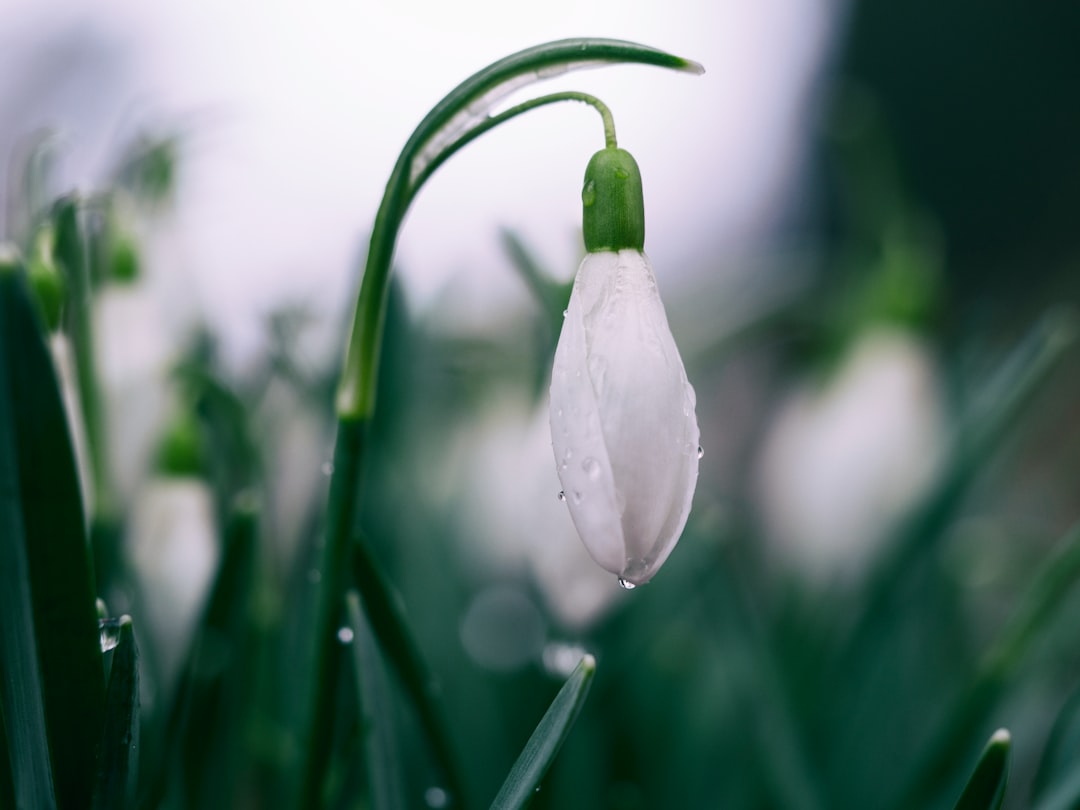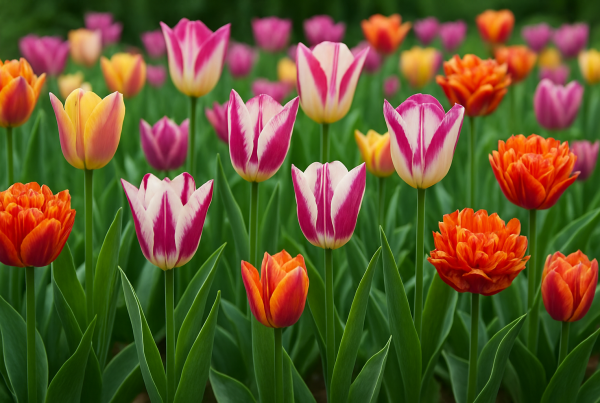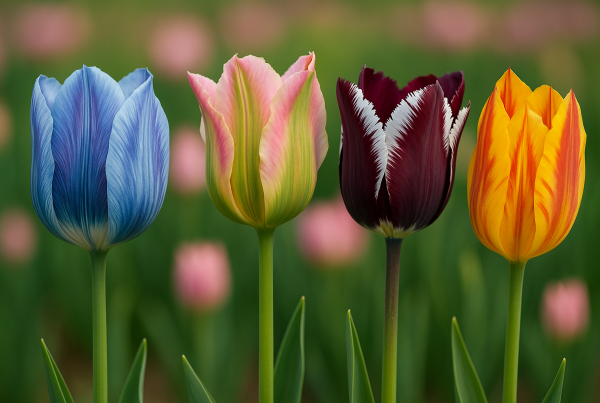Mastering the Art of Planting Tulips: Seasonal Tips for Novice and Expert Gardeners Alike
Tulips, with their vibrant colors and elegant shapes, have long captivated gardeners and flower enthusiasts around the globe. As one of the most beloved springtime blooms, mastering the art of planting tulips can bring both novice and expert gardeners immense satisfaction and joy. This guide will journey through the fascinating history of a tulip, explore the diverse tulip species and their scientific name, and provide seasonal tips to ensure that your tulip planting efforts result in a dazzling display. Whether you’re wondering about the history of tulips in Europe or curious about where tulips are found in the world, you’ll find inspiration and practical advice to nurture your gardening passion. Join us as we delve into the enchanting world of tulips and transform your garden into a stunning tapestry of color and life.
The Fascinating History of Tulips
Origins and Early Significance
The history of a tulip traces back to the wilds of Central Asia, where these flowers originally grew on the rugged mountainsides. Tulips were first cultivated by the Turks as early as the 10th century. Their cultivation spread quickly across the Ottoman Empire, where they became a symbol of wealth and prestige. During the 16th century, tulips were introduced to Europe, sparking what is now known as “Tulip Mania” in the Netherlands. This period saw tulip bulbs become so coveted that they were traded for exorbitant sums, sometimes costing more than a house. While Tulip Mania eventually subsided, tulips became firmly embedded in European horticulture and culture. Today, the Netherlands remains synonymous with tulips, producing billions of bulbs annually. Understanding these origins helps us appreciate the tulip’s journey from a wildflower to a cultivated gem that graces gardens worldwide.
History of Tulips in Europe
The history of tulips in Europe began in the late 16th century when the first tulip bulbs were sent from the Ottoman Empire to Vienna, Austria. From there, the fascination with tulips spread rapidly across Europe, particularly to the Netherlands. The Dutch embraced tulips with fervor, leading to the phenomenon known as “Tulip Mania” in the early 17th century. During this period, tulip bulbs were traded at extraordinarily high prices, with some bulbs worth more than gold. The peak of Tulip Mania saw a single bulb sold for the price of a luxurious house. Although the market eventually crashed, the tulip had firmly established its place in European horticulture. The Netherlands became the epicenter of tulip cultivation, a legacy that continues to this day. Dutch tulips are now a global symbol of beauty and are celebrated annually during tulip festivals throughout Europe.
Where Are Tulips Found in the World
Tulips are found in diverse climates and regions across the globe, demonstrating their adaptability and appeal. Originally native to Central Asia, wild tulips can still be seen flourishing in countries like Kazakhstan and Iran. As tulips spread through cultivation, they became synonymous with the Netherlands, which is now the largest producer of tulip bulbs worldwide. Beyond Europe, tulips have found favorable growing conditions in North America, particularly in the Pacific Northwest and parts of Canada. In Asia, countries like Turkey, where tulips were first cultivated, continue to celebrate these flowers with vibrant displays. Tulips are also popular in New Zealand and Australia, where they thrive in cooler climates. From the bustling tulip markets of Amsterdam to the tranquil gardens of Japan, tulips grace landscapes worldwide, captivating enthusiasts with their beauty and variety.
Choosing the Right Tulip Varieties
Popular Tulip Species
When selecting tulips for your garden, understanding the available tulip species is essential to creating a vibrant display. Among the most popular are the Darwin Hybrid Tulips, renowned for their large, bright blooms and sturdy stems, making them ideal for windy gardens. Another favorite is the Triumph Tulip, known for its classic shape and extensive color range, perfect for those looking to add a splash of color. For a touch of elegance, consider the Lily-Flowered Tulips, distinguished by their pointed petals and graceful silhouette. Species tulips, such as Tulipa tarda and Tulipa clusiana, bring a natural charm and are well-suited to rock gardens or wildflower settings. Additionally, Parrot Tulips offer an exotic appeal with their ruffled petals and bold hues. Each species offers unique characteristics, allowing gardeners to choose varieties that best fit their aesthetic and environmental needs.
Rare and Unique Varieties
For those seeking tulips that stand out, rare and unique varieties offer distinctive beauty and intrigue. The Black Tulip, or Queen of Night, captivates with its deep, velvety petals that appear almost black in certain lights, adding dramatic flair to any garden. Another striking choice is the Rembrandt Tulip, celebrated for its bold streaks and feathered patterns, reminiscent of the painted masterpieces of the Dutch Golden Age. The Green Tulip, or Viridiflora, presents a unique palette with its green-striped petals, offering a refreshing alternative to traditional blooms. For a truly exotic look, the Fringed Tulips, with their delicate, fringed edges, provide a textured and whimsical appearance. Each of these varieties brings a sense of rarity and elegance, perfect for gardeners looking to create a memorable and unique floral display. Exploring these exceptional tulip types allows for personalized and extraordinary garden designs.
Understanding Tulip Scientific Name and Family
Tulips belong to the genus Tulipa within the family Liliaceae, which includes other well-known plants such as lilies and onions. The tulip scientific name and family affiliation help gardeners and botanists classify and understand these flowers better. Each tulip species has its own scientific name, often reflecting its distinct characteristics or the region where it was first discovered. For instance, Tulipa gesneriana, one of the most common garden varieties, is named after the Swiss botanist Conrad Gessner. Understanding these scientific classifications not only aids in proper identification but also provides insights into the plant’s care requirements and potential growing conditions. Recognizing the tulip’s family ties can also help gardeners draw parallels with other Liliaceae plants, potentially enhancing their overall horticultural knowledge and gardening success.
Planting and Caring for Tulips
Seasonal Planting Tips
Successfully planting tulips requires attention to seasonal conditions and timing. For most regions, the ideal time to plant tulip bulbs is in the fall, when the soil has cooled to around 60 degrees Fahrenheit. This allows the bulbs to establish roots before winter sets in. In warmer climates, where winters are mild, consider pre-chilling bulbs in a refrigerator for 10-12 weeks before planting to simulate a cold dormant period. When planting, choose a well-drained, sunny location, and plant bulbs about 6-8 inches deep, with the pointed end facing upwards. Group them in clusters for a natural look. In the spring, tulips will begin to emerge as temperatures rise. It’s important to monitor weather conditions, as late frost can damage emerging shoots. Mulching can help insulate the bulbs and maintain moisture levels. By following these seasonal tips, gardeners can ensure a vibrant and successful tulip display.
Year-Round Maintenance
Caring for tulips involves attention throughout the year to ensure their health and beauty. After the blooming season, it’s crucial to let the foliage die back naturally. This process allows the plant to store energy in the bulb for the next season. Avoid cutting back the leaves until they turn yellow and wither. During summer, when tulips are dormant, ensure the soil isn’t overly saturated to prevent bulb rot. In regions with wet summers, consider lifting the bulbs and storing them in a cool, dry place until replanting in the fall. In winter, a layer of mulch can protect bulbs from extreme temperatures and frost heave. Regularly check for pests, such as aphids and slugs, which can damage the bulbs and foliage. By implementing these maintenance practices year-round, gardeners can enjoy healthy, vibrant tulips that return each spring with renewed vigor.
Troubleshooting Growing Issues
Growing tulips can occasionally present challenges that require troubleshooting. A common issue is poor blooming, often caused by insufficient chilling of bulbs or overcrowding. Ensure bulbs experience a cool, dormant period and are spaced adequately to allow room for growth. Pests, such as tulip fire fungus and bulb rot, can also affect tulips. To prevent these, plant in well-drained soil and avoid overwatering. If foliage appears withered or discolored, inspect for aphids and slugs, and use appropriate pest control measures. Another problem could be tulip bulbs failing to emerge, which might be due to rodents feeding on them. Consider using wire mesh or deterrents to protect bulbs underground. Lastly, if flowers are stunted, check soil nutrient levels; a balanced fertilizer can help. By identifying and addressing these issues early, gardeners can maintain healthy tulip plants and ensure a vibrant display in the spring.















